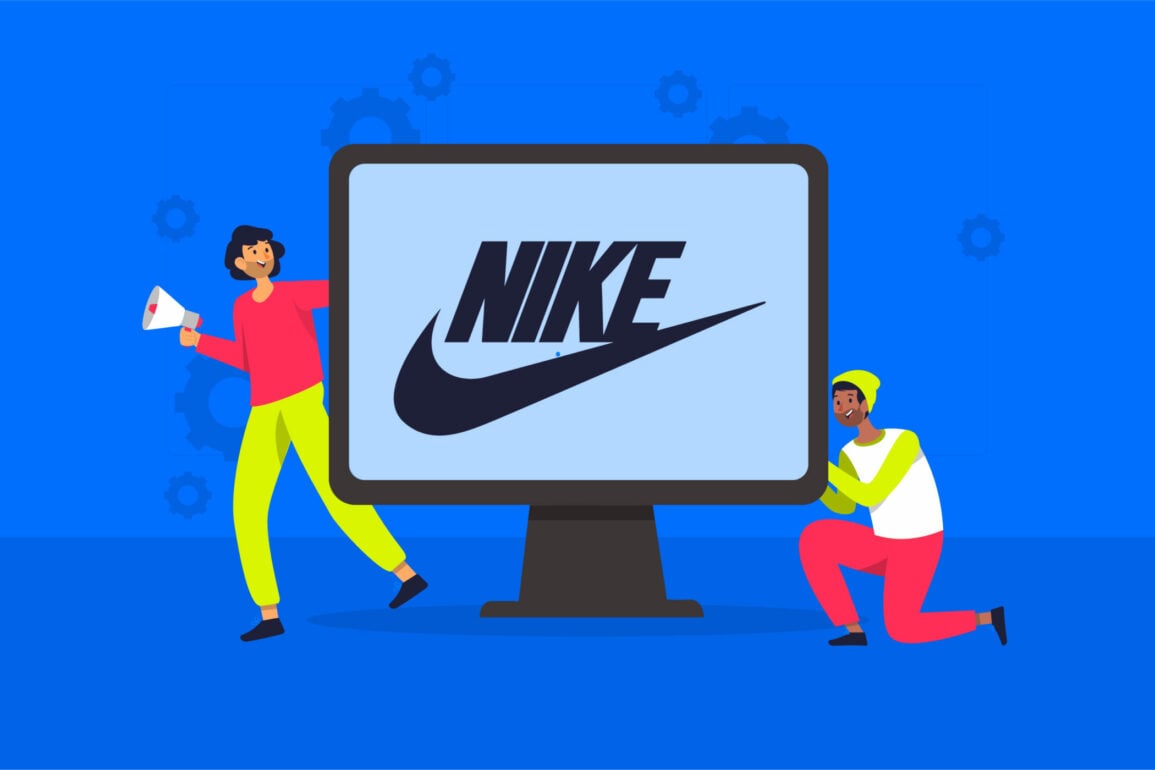How the Nike brand positioning strategy conquered all

The Nike brand positioning strategy is an excellent example of how the right position can make all the difference to a company’s chances of success. Nike has become the ultimate athletic brand by selecting the ideal target audience, championing certain values, and understanding its competition.
While countless other companies in the athletic apparel world sell products similar to Nike, few have achieved the same market presence or customer loyalty. The simple reason is that Nike is an expert in brand positioning.
The company knows how to connect with its customers emotionally and differentiate itself from the competition.
Nike not only presents itself as a leader in the athletic market with innovative new products and solutions, but it also understands how to cultivate loyalty by aligning itself with the values of its customers.
Today, we will be taking a closer look at the Nike positioning strategy and why it has been so crucial to the development of the brand.
An introduction to Nike brand positioning
Nike is one of the most successful athletic clothing providers in the world. Today, the company boasts a market share of approximately 30% in the athletic footwear space alone. Thanks to the Nike brand positioning strategy, demand for the organization’s solution has grown consistently for decades.
The business was first launched in 1964 by Bill Bowerman and Phil Knight. These two former athletes already had a strong understanding of the industry they were entering into.
They knew the challenges professional athletes faced and resolved to create products capable of addressing the key pain points and goals of their target audience.
The company’s mission revolves around nurturing and enhancing human potential across all communities.
While Nike started its journey with a focus on developing sports equipment and accessories for professionals, it quickly evolved to focus on a wider market, ensuring everyone could be an athlete, no matter their background.
As Nike has continued to unveil new products in its industry, its excellent focus on brand positioning and market segmentation has ensured it can maintain a consistent presence in the minds of customers. For many, Nike is a global supporter of athletic achievement.
It serves customers worldwide through physical and online stores and creates products to address a range of use cases.
What is the Nike brand positioning strategy?
When the founders of Nike launched their company in the United States, they did so with a deep understanding of the market they wanted to serve.
Phil Knight and Bill Bowerman knew the value of having the right athletic shoes to promote performance. They also knew what kind of challenges their customers were facing.
At the time when the company was launched, very few organizations were producing solutions specifically catered to the needs of athletes.
To begin with, Nike products focused specifically on addressing this under-served market. Like many organizations, Nike had its own niche market to cater to. However, as Nike continued to evaluate the landscape over the years, it changed its definition of who could be considered an “athlete.”
Nike’s founders believed everyone should have the ability to perform well in their chosen sport or activity, regardless of whether they were running for marathons or hitting the gym.
Through a careful evaluation of its market, Nike discovered a unique way of updating their product offering to appeal to customers from virtually every landscape.
Today, the Nike brand strategy revolves around turning everyone into the “hero” of their own story. The company uses its marketing strategies and branding to consistently motivate and empower customers, demonstrating that the only barrier to achievement is us.
What is Nike’s brand positioning statement?
To fully understand the Nike brand positioning strategy, it’s worth taking a look at the company’s internal “positioning statement.” A brand positioning statement is a crucial strategic document used by companies to help cultivate the right marketing campaigns and brand image.
The Nike brand positioning statement is as follows:
“For athletes in need of high-quality, fashionable athletic wear, Nike provides customers with top-performing sports apparel and shoes made of the highest quality materials. Its products are the most advanced in the athletic apparel industry because of Nike’s commitment to innovation and investment in the latest technologies.”
This simple positioning statement has helped to guide Nike through the creation of countless marketing strategies and the development of different products.
In every marketing plan produced by the company, the team leverages this positioning statement to ensure they’re sending the right message to their customers.
The Nike brand positioning statement clearly outlines how its products are created to better serve athletes. However, the lack of exclusionary language also demonstrates Nike’s belief that anyone can be an athlete, even if you’re not competing in your chosen sport.
As such, Nike can expand its marketing campaigns to appeal to different age groups, genders, and demographics.
The Nike brand strategy: Key components
Nike’s brand positioning statement has also assisted the company in developing the rest of the organization’s brand identity. After all, a positioning statement helps companies to determine their competitive advantage, target audience, and the unique value they’ll bring to customers.
Nike’s brand positioning statement has allowed it to focus on connecting with its audience based on the values of inclusivity and empowerment. Let’s take a look at some of the other key branding components which establish Nike as a market leader.
Nike’s brand promise
Nike’s brand promise, one of the core components of its positioning strategy and marketing plan, is to “bring inspiration and innovation to every athlete in the world.” We can see how Nike delivers on this promise in a number of ways.
For instance, the company creates high-quality products for virtually every kind of athlete, from runners and cyclists to weight lifters and golfers.
Nike’s marketing campaigns also highlight this core promise. To give one example, this video ad shows us how Nike is committed to inspiring every athlete, regardless of who they are. Nike doesn’t discriminate over who can be classified as an athlete.
It welcomes everyone into its community.
Nike’s visual identity
A strong market positioning strategy is core to creating an effective visual identity. When you’re designing a logo, color palette, or website, it’s important to know how you’re trying to present yourself to your target audience.
A core aspect of Nike’s positioning strategy is “quality.” As such, the organization has built its visual identity around this focus on excellence.
The check mark swoosh logo is synonymous with accomplishment and success. It’s also a motivational image, one designed to encourage and support customers. The smooth design even symbolizes innovation and speed, demonstrating Nike’s commitment to constant evolution.
Nike’s brand personality
Nike positions itself as a champion of the people. It aims to generate excitement around the concept of sports and athletic movement in everything it does. As such, its brand personality constantly conveys encouragement, support, and motivation.
Every message produced by the brand aims to tell customers they have the power to accomplish anything.
Just look at the famous Nike slogan, for instance, “Just Do It.”
The slogan is aspirational and provocative. It pushes people to overcome their internal issues and discover their true potential. Nike’s classic tagline, when combined with the Nike logo, highlights the company’s confidence and commitment to helping others.
Nike’s target market: The Nike customer segments
A brand positioning strategy pushes companies to look at a number of factors to determine how it can present itself in the context of a wider industry. Businesses use their positioning strategy to define their competitors, understand their unique selling points, and determine their target audience.
Part of what makes the Nike brand positioning strategy so effective is how well the company understands its market. Nike aims to appeal to a number of different customers with its product collection.
As such, the company takes advantage of market segmentation, dividing clients into groups based on their needs, interests, and priorities.
Generally speaking, Nike’s target market is relatively broad, consisting of all people between the ages of around 15 and 55 from a range of different backgrounds. However, to ensure it reaches its target customers effectively, Nike creates different products and ad campaigns for each segment.
Nike behavioral segmentation
From a behavioral perspective, Nike focuses on targeting customers who want to improve their lives, achieve health benefits, and essentially reach their goals. On a broad scale, the company aims to appeal to anyone who has a desire to accomplish something.
However, each of Nike’s products addresses a specific behavioral need for its customers.
Nike creates products for people who are striving to become the best athlete in the world, as well as those looking for an affordable way to start working on their physical health. Nike also encourages its customers to share their experiences with their friends and family through social media campaigns.
Nike geographic segmentation
As a multinational corporation, Nike serves a worldwide market. The company has built physical stores in various parts of the world to serve local customers. The company also has a strong online presence, designed to help customers in the digital landscape purchase products anywhere.
Notably, the company understands that each country comes with its own cultures and habits.
Nike produces different products for different customers based on their location and their specific needs. In New Delhi, India, the company focuses heavily on promoting cricket equipment. In Sydney and England, there’s a strong focus on promoting soccer and rugby products.
In the United States and North America, advertisements cater to baseball and American football.
Nike psychographic segmentation
From a psychographic perspective, Nike tailors its unique selling proposition to the interests and needs of different groups. The company regularly creates marketing campaigns based on the core concerns of customers in specific areas.
The company often associates itself with LGBT movements and initiatives like the “Black Lives Matter” campaign.
Nike’s products are also promoted with the support of different athletes, based on the connections customers feel to specific thought leaders. In the basketball space, Nike works with names like Lebron James and Michael Jordon on celebrity endorsements.
In the golfing space, the company has worked with famous athletes like Tiger Woods.
Core components of Nike’s brand positioning strategy
Looking back throughout the history of Nike’s marketing strategy and positioning efforts, it’s easy to be overwhelmed by the number of celebrity endorsements and distinct campaigns. One of the best things about Nike is that it adapts to the needs of its audience over time.
The company pays close attention to the values of its customers as they evolve and ensures its position in the market is relevant to the time. However, if we inspect Nike’s strategy on a deeper level, we can see some key areas where the positioning statement of Nike constantly shines through.
Some of the most consistent elements of Nike’s brand positioning strategy include:
1. A commitment to constant evolution
“Commitment to innovation” is one of the crucial components of Nike’s positioning strategy. The company’s vision revolves around constantly improving the lives of its customers by creating new, more effective solutions to their problems.
As a result, Nike’s products rarely stay static for long.
From day one, founder Bill Bowerman was tinkering with runner shoes, making small tweaks and experimenting with fabrics and components to optimize the performance of each pair. This focus has remained with the brand across the decades.
Not only are Nike shoes constantly evolving with new technologies and features, but all of the company’s products undergo the same innovation.
Nike consistently focuses on finding new ways to create the perfect shoe, the perfect shirt, or just the right equipment for its target audience. Nike’s commercials also consistently draw attention to how the company has enhanced its products based on its understanding of its customer’s expectations.
2. Knowing its customer
To provide customers with “top performing” solutions in the athletic landscape, Nike needs to understand the needs of its audience. Nike’s marketing activities and strong brand position are based on consistent research into its target market.
The company not only pays attention to feedback from customers shared online but conducts regular tests and focus groups too.
Over time, Nike has developed a name for itself as a leader in its space.
As such, it knows its customers have high expectations when it comes to the quality and performance of its products. The company, therefore, commits to working with different innovators and leaders to ensure it delivers solutions according to its customer expectations.
Nike carefully evaluates not just athletes like Michael Jordan and Lebron James but everyday people and how their quest for athletic performance is hampered by different factors. This allows the company to produce solutions that not only meet but exceed customer’s expectations.
The development of unique personas and marketing strategies for different groups also ensures Nike can tailor specific strategies to its market segments around the world.
3. Being an inspiration
Nike’s mission isn’t just to provide customers with high-quality products but to inspire them to make the most out of their bodies. The company wants to inspire, motivate, and encourage its audience to accomplish more. To do this, they make their customer central to their brand.
In other words, rather than focusing on comparing their items to the solutions offered by competitors or giving customers long lectures on the scientific value of their items, Nike positions the customer as the hero in their marketing campaigns.
Virtually every well-known Nike advertisement revolves around sharing the stories of real people who have accomplished amazing things.
Nike inspires its customers by showing them exactly what they can accomplish with the right products. Nike positions itself as the partner customers can use to achieve their goals and reminds them what they’re capable of with inspiring, motivational campaigns.
4. A consistent focus
While Nike produces a variety of products within the athletic landscape, it still focuses on one core thing – empowering people. The company doesn’t branch out into different, unusual partnerships with other brands just to expand its potential market share.
The company understands its core essence and focus. It wants to turn everyone into an athlete.
By maintaining a consistent focus throughout the years, Nike has helped to establish its position as a true market leader. The company never strays from its core goals and vision. It doesn’t get distracted trying to lower prices to beat the competition or explore extra environments like sports drinks.
Nike is committed to serving athletes with the solutions they need most. It’s this brand consistency that makes the company more trustworthy in the eyes of its target audience. Even after decades of development, Nike hasn’t strayed from its core mission or vision.
The brand Nike creates for itself is based on a solid foundation and one main message: anyone can be an athlete.
5. Cultivating authority
Finally, Nike has always positioned itself as a leader in its space. It does this not just by producing high-quality products and solutions based on extensive research but also by connecting itself with the right people.
A lot of Nike’s advertising strategies focus on aligning the organization with reputable names in different sporting industries.
The company has even built entire product collections with the help of major celebrities, like the Air Jordan signature shoes. Aligning itself with serious athletes and professionals in its industry ensures Nike can continue to position itself as a true leader in its industry.
It shows the company’s commitment to being the very best by aligning it with reputable individuals.
Notably, as well as working with leading authorities in the sporting space, Nike also demonstrates its commitment to empowering everyone by inviting numerous micro-influencers and everyday people to take part in its marketing campaigns.
Across its social channels and marketing campaigns, Nike combines testimonials from leading athletes with insights from commonplace consumers.
Learning from the Nike brand strategy
The Nike brand positioning strategy has helped the athletic brand become one of its industry’s most powerful leaders.
Nike has taken the world by storm through a careful focus on core values, an understanding of its unique target audience, and a commitment to exceeding the customer’s expectations. Today, Nike is a name virtually everyone is familiar with around the world.
Although the company has faced formidable competition in the sports industry, it has never lost sight of its core values and vision.
The company’s strong positioning statement has ensured Nike can consistently send the right message to its customers, demonstrating why it is the ultimate partner for sporting success.
For companies looking to establish their brand positioning statement, learning from Nike could be one of the best ways to boost your chances of success.
If you can follow the company’s lead when it comes to making an emotional impact, delivering a consistent message, and cultivating authority, there’s a good chance you can thrive in your industry too.
Of course, if you need extra help positioning yourself in your consumers’ minds, you can always work with the team here at Fabrik.
We’ll help you define your potential market segment, determine the best option for your positioning strategy, and ensure you can separate your brand from the competition.
Reach out to us today for help building a brand positioning strategy as powerful as the one developed by Nike.
Fabrik: A branding agency for our times.
Now read these:
—How to become a Nike brand ambassador
—Discover the Nike logo history and evolution
—The shoe brand with the Jumpman logo






















